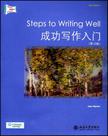成功写作入门
2008-9
北京大学出版社
吉恩·埃里克
594
无
北京大学出版社2008年最新引进了一套国外畅销的《英语写作原版影印系列丛书》,并邀请我为这套丛书写序,谈谈我对英语写作教学与研究的一些认识。我仔细翻阅后,觉得这套书特色十分鲜明,其中有几本再版达十次以上,经久不衰,非常乐意在此推荐给我国的广大读者。 在经济全球化和网络高度发达的今天,学好英语已变得十分重要,英语口头与书面语的表达能力已逐渐成为当今的核心竞争力之一,从第二语言学习的社会文化观看,能否流利地运用外语进行口头或书面交流已直接关系到学生的就业和未来发展。
《成功写作入门》于1979年首次出版,已再版十次,盛销不衰。本书内容丰富,与写作相关的概念和步骤,都佐以具体事例进行清晰明了的讲解。作者熟悉和了解当代大学生,以其为背景的素材,信手拈来。作者引导读者循序渐进地进行学习和练习英语写作。书中大量的学生习作和专家范文相得益彰。每章后的练习和作业都与正文内容相匹配,帮助教师及时检查学生是否掌握了所学内容。 传统的大学写作课程、教材或写作手册往往枯燥、生硬、充满了条条框框,令学生望而生畏,本书作者则文笔流畅,语调风趣、幽默,循循善诱,对所讲内容深入浅出,娓娓道来,引人入胜。此外,本书版面设计新颖,精选的图片有助于学生放松心情,活跃思维,激发他们写作的愿望与创作的激情。
Jean Wynck,是美国科罗拉多州立大学的荣誉退休教授,曾任该校写作教研部主任11年之久。她有丰富的教学经验,在近30年的教学生涯中,主讲过本科英语写作课、培训过英语写作教师并担任多项写作研究项目的负责人。此外,她还著有“The Rinehart Reader”和“Discovering Ideas”等著作。她曾发表了二十多篇关于写作和美国文学方面的论文。目前她研究的主要内容包括19世纪晚期和20世纪初的美国小说、美国研究以及妇女研究。她出版的三本大学写作教材都曾多次再版。
Part One The Basics of the Short Essay1 PrewritingGetting Started (or Soup-Can Labels Can Be Fascinating)Selecting a SubjectFinding Your Essays Purpose and FocusPump-Primer TechniquesAfter Youve Found Your FocusPracticing What You’ve LearnedDiscovering Your AudienceHow to Identify Your ReadersPracticing What Youve LearnedAssignmentKeeping a Journal (Talking to Yourself Does Help)Chapter 1 Summary2 The Thesis StatementWhat Is a Thesis? What Does a "Working Thesis" Do?Can a "Working Thesis" Change?Guidelines for Writing a Good ThesisAvoiding Common Errors in Thesis StatementsPracticing What Youve LearnedAssignmentUsing the Essay MapPracticing What Youve LearnedAssignmentChapter 2 Summary3e Topic Sentence 50Focusing Your Topic SentencePlacing Your Topic SentencePracticing What Youve LearnedAssignmentApplying What Youve Learned to Your WritingParagraph DevelopmentParagraph LengthPracticing What Youve LearnedAssignmentApplying What Youve Learned to Your WritingParagraph UnityPracticing What Youve LearnedApplying What Youve Learned to Your WritingParagraph CoherencePracticing What Youre LearnedParagraph SequenceTransitions between ParagraphsApplying What Youve Learned to Your WritingChapter 3 Summary4 Beginnings and EndingsHow to Write a Good Lead-inAvoiding Errors in Lead-insPracticing What Youve learnedAssignmentHow to Write a Good Concluding ParagraphAvoiding Errors in ConclusionsPracticing What Youre LearnedAssignmentHow to Write a Good TitlePracticing What Youve learnedAssignmentApplying What Youve Learned to Your WritingChapter 4 Summary5 Drafting and Revising: Creative Thinking, Critical ThinkingWhat Is Revision?When Does Revision Occur?Myths about RevisionCan I Learn to Improve My Revision Skills?Preparing to Draft some Time-Saving HintsAdditional Suggestions for Writers with Word ProcessorsWriting Centers, Computer Labs, and Computer ClassroomsA Revision Process for Your DraftsI. Revising for Purpose, Thesis, and AudienceII. Revising for Ideas and EvidenceⅢ. Revising for OrganizationIV. Revising for Clarity and StyleV. Editing for ErrorsVI. ProofreadingA Final Checklist for Your EssayPracticing What Youve LearnedBenefiting from Revision WorkshopsPracticing Youre LearnedAssignmentSome Last Advice: How to Play with Your Mental BlocksChapter 5 Summary6 Effective Sentences7 Word Logic8 The Reading-Writing ConnectionPart Two Purposes, Modes, and Strategies9 Exposition10 Argumentation11 Description12 Narration13 Writing Essays Using Multiple StrategiesPart Three Special Assignments14 Writing a Paper Using Research15 Writing in Class: Exams and "Response" Essays16 Writing about Literature17 Writing about Visual Arts18 Writing about Film19 Writing in the World of WorkPart Four A Concise Handbook20 Major Errors in Grammar21 A Concise Guide to Punctuation22 A Concise Guide to MechanicsList of ArtworksList of Advertisements
Chapter Prewriting Getting Started (or Soup-Can Labels Can Be Fascinating) For many writers, getting started is the hardest part. You may have noticed that when it is time to begin a writing assignment, you suddenly develop an enormous desire to straighten your books, water your plants, or sharpen your pencils for the fifth time. If this situation sounds familiar, you may find it reassuring to know that many professionals undergo these same strange compulsions before they begin writing. Jean Kerr, author of Please Dont Eat the Daisies, admitted that she often found herself in the kitchen reading soup-can labels—or anything——to prolong the moments before taking pen in hand. John C. Calhoun, vice president under Andrew Jackson, insisted he had to plow his fields before he could write, and Joseph Conrad, author of Lord Jim and other novels, is said to have cried on occasion from the sheer dread of sitting down to compose his stories. To spare you as much hand-wringing as possible, this chapter presents some practical suggestions on how to begin writing your short essay. Although all writers must find the methods that work best for them, you may find some of the following ideas helpful.. The Basics of the Short Essay But no matter how you actually begin putting words on paper, it is absolutely essential to maintain two basic ideas concerning your writing task. Before you write a single sentence, you should always remind yourself that 1. You have some valuable ideas to tell your reader, and 2. More than anything, you want to communicate those ideas to your reader. These reminders may seem obvious to you, but without a solid commitment to your own opinions as well as to your reader, your prose will be lifeless and boring. If you dont care about your subject, you cant very well expect anyone else to. Have confidence that your ideas are worthwhile and that your reader genuinely wants, or needs, to know what you think. Equally important, you must also have a strong desire to tell others what you are thinking. One of the moist common mistakes inexperienced writers make is failing to move past early stages in the writing process in which they are writing for————or writing to——-themselves only. In the first stages of composing an essay, writers frequently "talk" on paper to themselves, exploring thoughts, discovering new insights, making connections, selecting examples, and so on. The ultimate goal of a finished essay, however, is to communicate your opinions to others clearly and persuasively. Whether you wish to inform your readers, change their minds, or stir them to action, you cannot accomplish your purpose by writing so that only you understand what you mean. The burden of communicating your thoughts falls on you, not the reader, who is under no obligation to struggle through confused, unclear prose, paragraphs that begin and end for no apparent reason, or sentences that come one after another with no more logic than lemmings following one another to the sea.

无
成功写作入门书评
很满意撒~
成功写作入门(第10版)
我的妈妈呀,